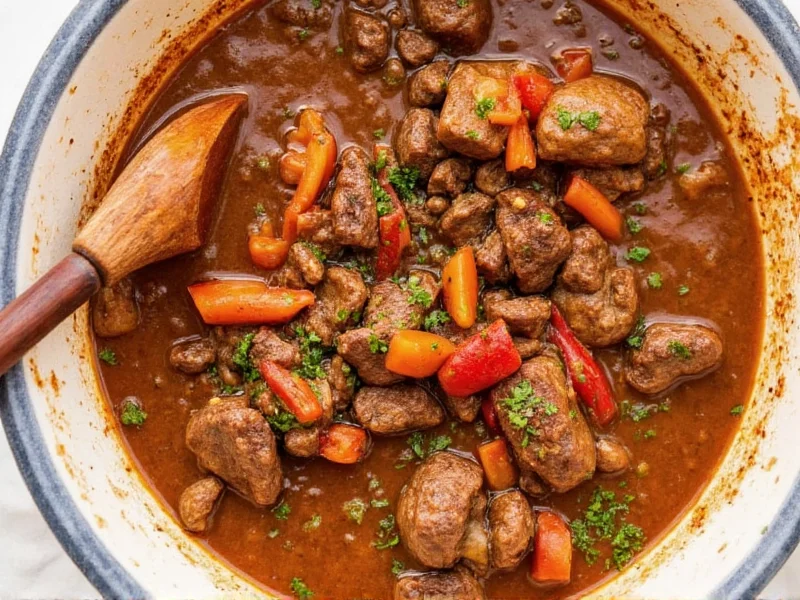Beef stew represents culinary tradition at its finest—a dish where patience meets perfect seasoning. The magic happens when humble ingredients transform through slow cooking, but the foundation of exceptional stew lies in thoughtful spice selection. Many home cooks underestimate how specific spices interact with beef's rich umami, creating either harmony or discord in the final dish.
Essential Spices for Beef Stew: Flavor Science Explained
Understanding why certain spices work with beef requires examining flavor chemistry. Beef contains glutamates that respond beautifully to particular aromatic compounds found in specific herbs and spices. Let's explore each essential component:
Bay Leaves: The Foundation of Depth
Bay leaves provide subtle bitterness that balances beef's richness without overpowering. Their eucalyptol content creates a clean finish that prevents the stew from tasting greasy. Always use dried bay leaves (fresh contain potentially harmful compounds) and remove them before serving. Two leaves suffice for a standard 6-quart pot—more creates medicinal notes.
Thyme: The Herbal Anchor
Thyme's thymol compound binds with meat proteins during cooking, enhancing savory perception. Dried thyme works better than fresh in stews because its concentrated flavor withstands long cooking. One teaspoon of dried thyme equals four sprigs of fresh. For best spices for traditional beef stew, combine thyme with a small piece of orange zest to brighten the earthiness.
Black Pepper: Controlled Heat
Contrary to popular belief, freshly cracked black pepper added at the beginning—not the end—creates superior flavor integration. The piperine in pepper breaks down during cooking, mellowing its bite while maintaining warmth. Half a teaspoon provides enough background heat without dominating. Avoid pre-ground pepper, which loses volatile oils quickly.
Smoked Paprika: The Secret Weapon
Smoked paprika adds complexity through guajillo peppers dried over oak fires. Its capsaicin content is minimal, making it ideal for what spices go well with beef stew without heat concerns. The smoked variety (not sweet or hot) contributes 20+ aromatic compounds that mimic slow-cooked depth. One teaspoon creates rich color and subtle smokiness that complements seared beef beautifully.
Rosemary: The Bold Companion
Rosemary's camphor notes cut through fat effectively but require careful handling. Too much creates pine-sol flavors. Half a teaspoon of dried rosemary (or one small sprig fresh) balances perfectly. Add it during the last 30 minutes of cooking to preserve its volatile oils. For authentic beef stew spice combinations, pair rosemary with a single clove of garlic for aromatic synergy.
| Spice | Flavor Contribution | Optimal Amount (per 2 lbs beef) | Add When |
|---|---|---|---|
| Bay Leaves | Earthy depth, bitterness balance | 2 leaves | Beginning |
| Dried Thyme | Herbal complexity, umami enhancement | 1 tsp | Beginning |
| Black Pepper | Warmth, flavor integration | 1/2 tsp | Beginning |
| Smoked Paprika | Color, subtle smokiness | 1 tsp | Last 30 minutes |
| Dried Rosemary | Piney notes, fat-cutting | 1/2 tsp | Last 30 minutes |
Avoiding Common Spice Mistakes in Beef Stew
Many home cooks make critical errors that undermine their stew's potential. Understanding how to season beef stew properly prevents these pitfalls:
- Overusing garlic: More than one clove creates sharp bitterness as it breaks down during cooking
- Adding delicate herbs too early: Rosemary and oregano lose complexity when simmered for hours
- Using pre-mixed blends: Commercial "stew seasonings" often contain excessive salt and fillers
- Skipping acid balance: A tablespoon of tomato paste or red wine vinegar brightens heavy flavors
Regional Variations and Modern Twists
While classic French and Irish stews rely on the core five spices, regional interpretations offer inspiration for ideal spice ratio for beef stew:
- French Bourguignon: Add one star anise with the bay leaves for subtle licorice notes that complement red wine
- American Midwest: Incorporate 1/4 teaspoon celery seed for earthy complexity without adding vegetables
- Southwestern Style: Replace paprika with ancho chili powder for mild heat and fruitiness
- Modern Fusion: A single strip of orange zest with thyme creates unexpected brightness
Remember that spice preferences remain personal—these variations demonstrate how small adjustments create distinct culinary identities while maintaining the stew's essential character.
Practical Application: Building Your Spice Profile
Follow this timeline for classic beef stew seasoning blend perfection:
- Season beef generously with salt and pepper before searing
- Add bay leaves, thyme, and black pepper to the pot when returning meat to liquid
- Stir in smoked paprika during the last 30 minutes of cooking
- Add rosemary with any tender vegetables (carrots, peas) for the final 20 minutes
- Finish with a splash of red wine vinegar to balance richness
This method ensures each spice contributes optimally at its peak flavor moment. The result? A deeply layered stew where herbs and spices that complement beef shine without competing.











 浙公网安备
33010002000092号
浙公网安备
33010002000092号 浙B2-20120091-4
浙B2-20120091-4